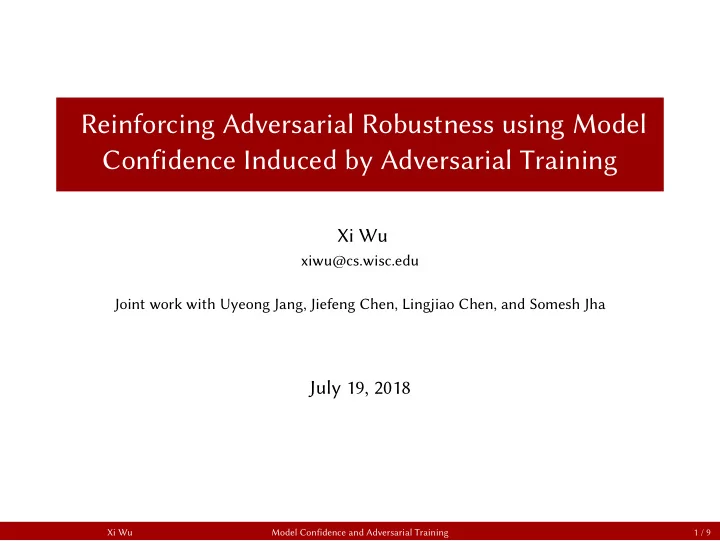

Reinforcing Adversarial Robustness using Model Confidence Induced by Adversarial Training Xi Wu xiwu@cs.wisc.edu Joint work with Uyeong Jang, Jiefeng Chen, Lingjiao Chen, and Somesh Jha July 19, 2018 Xi Wu Model Confidence and Adversarial Training 1 / 9
Entirely wrong behavior of confidence naturally trained neural network: Xi Wu Model Confidence and Adversarial Training 2 / 9 • Small perturbations can cause highly confident but wrong predictions. • An example from (Goodfellows, Shlens, and Szegedy, ICLR 2015), on a
A betuer behavior give natural data manifolds) Xi Wu Model Confidence and Adversarial Training 3 / 9 • Low confidence if the model “does not learn/know it.” • An intuitively good model for classifying pandas and gibbons (disks
Main contributions of this work data distribution. Xi Wu Model Confidence and Adversarial Training 4 / 9 • In a precise formal sense, adversarial training by (Madry et al., ICLR 2017) gives betuer behavior of model confidence for points near the • The betuer behavior of model confidence induced by adversarial training can be used to improve adversarial robustness.
Defining good behaviors of confidence (1/2) Intuition : Confident predictions of difgerent classes should be well separated. Xi Wu Model Confidence and Adversarial Training 5 / 9 A bad ( x , y ) ∼ D with poor confidence separation:
Pr Defining good behaviors of confidence (2/2) Xi Wu Model Confidence and Adversarial Training 6 / 9 • D : Data generating distribution; d ( · , · ) : A distance metric; p, q ∈ [0 , 1] , δ ≥ 0 . • Bad event (Neighborhood has p -confident wrong predictions): B = {∃ y ′ ̸ = y, x ′ ∈ N ( x , δ ) , F θ ( x ′ ) y ′ ≥ p } • F is said to have ( p, q, δ ) -separation if [ ] B ≤ q. ( x ,y ) ∼D
Adversarial Training by Madry et al. max Model Confidence and Adversarial Training Xi Wu Theorem (Informal, this work) Adversarial training formulation of Madry et al.: 7 / 9 minimize ρ ( θ ) , [ ] where ρ ( θ ) = ∆ ∈S L ( θ, x + ∆ , y ) E , ( x ,y ) ∼D For a large family of loss functions L , models trained as above achieve good ( p, q, δ ) -separation, where as p → 1 , q → 0 .
Empirical results (summary) confidence-based defenses (as well as gradient-masking efgect). baseline model of Madry et al. two neighbors with highest confidences. Xi Wu Model Confidence and Adversarial Training 8 / 9 • We generate high-confidence atuacks in order to bypass • Finding 1: Confidence of models trained using Madry et al.’s objective behave much betuer than their natural counterparts. • Finding 2: A simple “nearest neighbor search” based on confidence corrects 20 % ∼ 25 % targeted adversarial examples that fool the • Finding 3: For > 98 % of test instances, correct label can be found in
Qvestions? Please come to our poster session if you want to know more details! Xi Wu Model Confidence and Adversarial Training 9 / 9
Recommend
More recommend